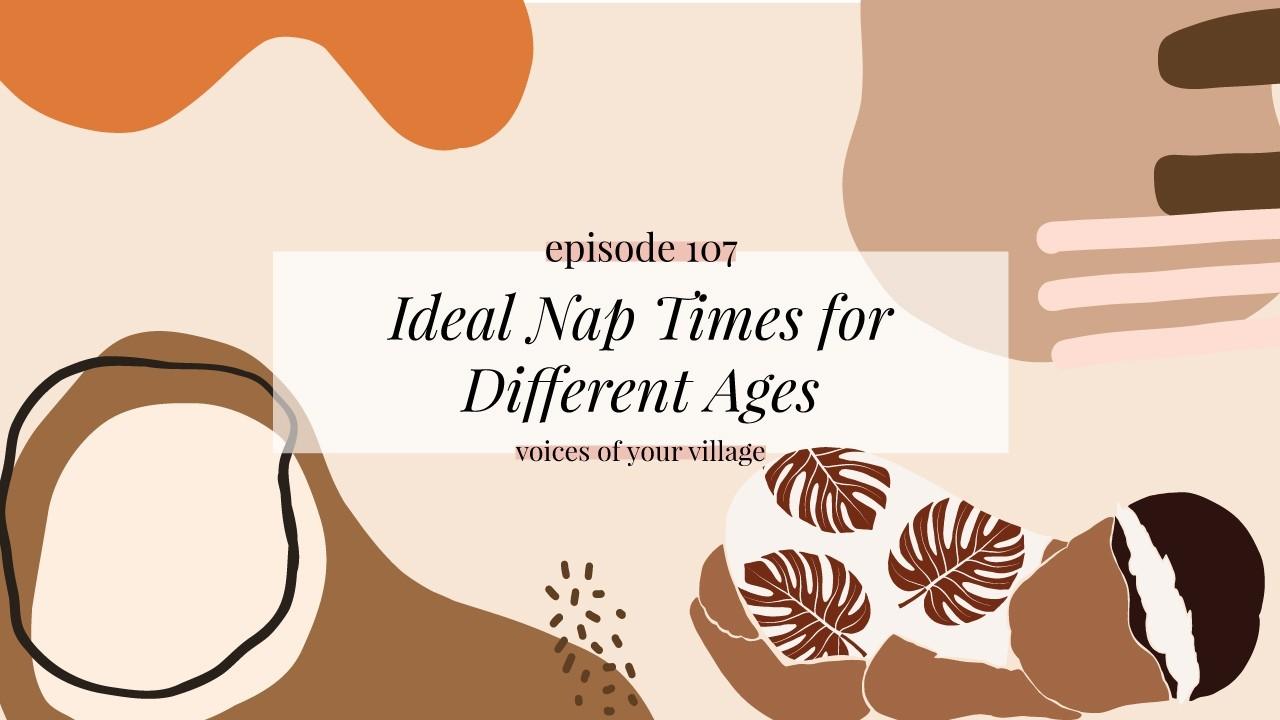Ideal Nap Times for Different Ages

Hello there, and welcome to episode 107 of Voices of Your Village! Today we are talking about everyone’s favorite topic… sleep regulation! More specifically, this week is a pen and paper in hand episode all about the specifics of ideal nap times for different ages. If you are looking for a deeper dive into sleep pressure and regulation, check out episode 41. Because today is all about the importance of timing and example napping schedules.
Sleep is a little like food- when you want your body to be ready to sit down for a meal at breakfast, lunch, or dinner you don’t have a snack 10 minutes before you are ready to eat.
When we want kiddos to take a long nap, sync their cycles, and sleep at night what we are first paying attention to is: during the day, what does their sleep look like? Are they over or under tired? If so, this will affect the length and quality of their overnight sleep.
When kiddos are up for too long, they get to a point of being overtired. They get this “second wind” you’re always hearing about where their bodies produce cortisol to keep them awake. Kids who have cortisol coursing through their body can be way cranky or really wild, this is their overtired self. If you can imagine having adrenaline pushing through your body, it can be really hard to find your calm.
While making sure their naps support their overnight sleep, let’s break this down to what exactly it looks like for each age and stage of your snoozy kiddo.
In the newborn phase we are paying attention to not getting overtired. Newborns nap so frequently and the only thing more important than the length of a nap is the length of awake time in between. Newborns might only be awake for 45 minutes between naps. The big thing here is that newborns should never be awake for more than 2 hours at a time, then their body will produce the cortisol that keeps them awake.
As kiddos get older, between 4 and 6 months old, a schedule will set in. We will see kiddos slide into three naps, most kiddos will maintain these 3 naps until they are 6-8 months old. Let’s look at a sample schedule for a kiddo at 3 naps. The first awake window should be about 2 hours long, say they wake up at 630 am their first nap is at 830. They sleep then for an hour and a half and their next awake period is 3 hours long. We are starting to stretch them a little longer in the middle of the day, so they go down at 1 pm and sleep until 230ish. They will then have a 2-hour awake window until 430, and then a cat nap before their final 2-hour awake window before bed. We are noticing here that our awake windows are about 2 hours, with the exception of after the first nap. That awake window is 2 and a half to three hours.
Then, as we move into 2 naps our awake windows are 2,3,4 (2 hours, then 3 hours, then 4 hours). This might start anywhere between 6 and 8 months. You’ll notice they are ready when their naps during the day are really short all of a sudden or, most commonly, you’ll find your kiddo refusing that last catnap of the day. (Check out episode 56 to dive into when to know when a kiddo is ready to move from 3 to 2, to 1 nap!)
So, your kiddo is on two naps and we want to hold that until your kiddo is between 12-15 months. Most kiddos will drop on their own to 1 nap at 15 months. Let’s take a look at that schedule.
Let’s say your kiddo wakes up at 630, they are going to go down for their first nap around 830/9. Then they are awake for 3 hours before going down for between 1 and 2 and a half hours. Then awake for 4 hours before bedtime. When your kiddo first moves to 2 naps you might find them doing a cat nap on their way home from childcare. Remember, an extra 10-15 nap will play a role in their overnight sleep so be cautious about them sneaking in this extra little nap.
Remember, awake time is more important than the length of naps. It doesn’t matter what time your kiddo goes to sleep at night as long as they are supported by their awake windows during the day.
Now, when they are ready to drop to 1 nap. We want them to hold this one nap until they are through their 3rd year, especially our kiddos with sensory processing challenges. Guys, this is crucial. This is where we see the biggest schedule challenge. The first wake time of the day should be 5 hours, and the second 6 hours. They should be sleeping 11 hours overnight with a 2-hour nap. If you find as your kiddo gets older they want a 1-hour nap, they should have a 5.5 wake in the morning and 6.5 in the afternoon.
You can head over to seedandsew.org/sleep to access our free sleep guide and any of our online sleep classes. When you join the sleep class you also join our village of folks who are also doing this sleep work behind the scenes.
Y'all, our whole approach to sleep is: are we setting our kiddos up for success? Are we establishing routines from an emotionally supportive place, that help kiddos feel regulated and in control of their space? We do not practice cy it out at any point, and are really focused on helping your build and maintain a secure attachment with your tiny human whether during the day or at night time.
